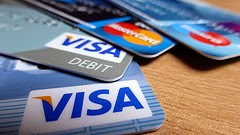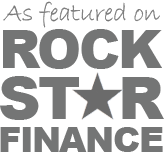Last week, I promised you I'd show you how to evaluate those balance transfer offers you get from your credit cards, so let's get into it, shall we?
Here's the situation: You're currently carrying a balance on a somewhat high interest credit card. I know, you broke the cardinal rule of credit cards by not paying off the balance in full each month. I'm not going to judge you for carrying a balance. There is no slut-shaming here. What's important is you realize you are wasting money paying that high interest rate and are ready to take steps to correct the problem.
Your current situation:
First off, congrats on making more than the minimum payment! It may not be much more, but it's all your budget can afford and you know every little bit extra helps. You also know that in order to get out of a hole, the first thing you have to do is stop digging, so you've resolved to not charge any more purchases until you get this debt paid off.
Let's see what this is costing you. We'll use the credit card calculator here and plug in values of $4,000, 15.95%, and a $150 payment. That shows it will take 34 months to pay off this debt and you will end up paying $972 in interest.
But today is your lucky day! You got a balance transfer offer in the mail from your other credit card (the one you are NOT carrying a balance on). It gives you two choices:
Which should you choose? That no fee one sounds better, doesn't it? Maybe that's the one to take? There's only one way to figure this out - we must use the maths! For each offer, we'll figure out how much it will cost us in total interest and then choose whichever one is the lowest. We will assume we will continue to make our $150 monthly payment - after all, that's in our budget and it's all we can afford.
We will be charged no interest for 18 months. This means for those 18 months, 100% of our payment will go towards reducing our balance. 18 * $150 = $2,700, so after 18 months, we'll have a remaining balance of:
$4,000 - $2,700 = $1,300
At this point, the interest kicks in at 11.99%. Going back to our credit card payment calculator, we plug in $1,300 for our balance, 11.99% for the interest rate, and $150 for the payment. It tells us this will be paid off in 10 months and we will have paid $67 in interest.
What's our total cost for Option 1? That is equal to our transfer fee plus our interest charges, or $120 + $67 = $187. The balance will be paid off in 18 + 10 months, or 28 months.
There is no balance transfer fee for this option, so we have no cost there.
For the first 21 months, we're paying 4.99% interest. This is $4,000 * .0499, or $199.60 per year (because interest rates are quoted on a yearly basis). Per month, this works out to $199.60 / 12, or $16.63 per month. So of our $150 monthly payment, $16.63 is going towards interest, leaving $133.37 per month to reducing the outstanding balance. After 21 months, the balance will be reduced by $133.37 * 21 = $2,800.77. So when our promotional interest rate expires, our outstanding balance will be:
$4,000 - $2,800.77, or $1,199.23. Let's call it an even $1,200.
The rest of the calculations are done just like they were for Option #1. We'll go back to our credit card payment calculator and plug in $1,200 for the balance, 11.99% for the interest rate, and $150 for the payment amount. It reports it will take us 9 months to pay off the balance and we will have paid $57 in interest.
What's our total cost for Option 2? That is equal to our transfer fee plus our interest charges, or $0 + ($16.67 * 21) + $57 = $407.07. The balance will be paid off in 21 + 9 months, or 30 months.
It's clear that Option #1 will cost us the least amount of money, even though it comes with a 3% balance transfer fee. That's the option we should choose.
Important! This analysis assumes you are not continuing to charge purchases to the card during this period. If you do, this whole analysis goes out the window. This is because credit card companies will apply any payments you make to your lowest interest rate (i.e. promotional) balances first. If you go with Option #1 and then charge another purchase to that card, none of your payments will go towards paying that purchase off until the promotional balance is paid off. So if your normal credit card rate is 11.99%, you will be charged that in interest on your new purchase for 28 months before you start paying that new purchase off. Odds are, that will wipe out your savings from the balance transfer.
Here's the situation: You're currently carrying a balance on a somewhat high interest credit card. I know, you broke the cardinal rule of credit cards by not paying off the balance in full each month. I'm not going to judge you for carrying a balance. There is no slut-shaming here. What's important is you realize you are wasting money paying that high interest rate and are ready to take steps to correct the problem.
Your current situation:
| Credit Card #1 | |
| Balance | $4,000 |
| Interest Rate | 15.95% |
| Minimum Payment | $120 |
| Actual Payment | $150 |
First off, congrats on making more than the minimum payment! It may not be much more, but it's all your budget can afford and you know every little bit extra helps. You also know that in order to get out of a hole, the first thing you have to do is stop digging, so you've resolved to not charge any more purchases until you get this debt paid off.
Let's see what this is costing you. We'll use the credit card calculator here and plug in values of $4,000, 15.95%, and a $150 payment. That shows it will take 34 months to pay off this debt and you will end up paying $972 in interest.
But today is your lucky day! You got a balance transfer offer in the mail from your other credit card (the one you are NOT carrying a balance on). It gives you two choices:
- 0% interest for 18 months, then 11.99% on the remaining balance, with a 3% or $10 balance transfer fee (whichever is more) or
- 4.99% for 21 months, then 11.99% on the remaining balance, with no balance transfer fee
Which should you choose? That no fee one sounds better, doesn't it? Maybe that's the one to take? There's only one way to figure this out - we must use the maths! For each offer, we'll figure out how much it will cost us in total interest and then choose whichever one is the lowest. We will assume we will continue to make our $150 monthly payment - after all, that's in our budget and it's all we can afford.
Option #1
This one is the easiest to calculate. First off, let's tackle the fee. Three percent of $4,000 is $120. That is more than the $10 minimum, so that's what our fee will be. Not looking too good so far.We will be charged no interest for 18 months. This means for those 18 months, 100% of our payment will go towards reducing our balance. 18 * $150 = $2,700, so after 18 months, we'll have a remaining balance of:
$4,000 - $2,700 = $1,300
At this point, the interest kicks in at 11.99%. Going back to our credit card payment calculator, we plug in $1,300 for our balance, 11.99% for the interest rate, and $150 for the payment. It tells us this will be paid off in 10 months and we will have paid $67 in interest.
What's our total cost for Option 1? That is equal to our transfer fee plus our interest charges, or $120 + $67 = $187. The balance will be paid off in 18 + 10 months, or 28 months.
Option #2
This one is a little more complicated to figure out, but we're going to make some assumptions to simplify things. Normally, loans are paid off on an amortization schedule, meaning even though you are making the same payment amount each month, as time goes on, more of that payment gets applied to principle and less to interest (because our outstanding balance is dropping and the interest charged on that amount will therefore also drop). We're going to ignore that and just assume the same amount goes to each portion each month, at least for the initial 21 month period. This means our interest calculation results will be slightly higher than what we would actually be charged, but it will be close enough to the actual value to be able to make a valid comparison to Option #1.There is no balance transfer fee for this option, so we have no cost there.
For the first 21 months, we're paying 4.99% interest. This is $4,000 * .0499, or $199.60 per year (because interest rates are quoted on a yearly basis). Per month, this works out to $199.60 / 12, or $16.63 per month. So of our $150 monthly payment, $16.63 is going towards interest, leaving $133.37 per month to reducing the outstanding balance. After 21 months, the balance will be reduced by $133.37 * 21 = $2,800.77. So when our promotional interest rate expires, our outstanding balance will be:
$4,000 - $2,800.77, or $1,199.23. Let's call it an even $1,200.
The rest of the calculations are done just like they were for Option #1. We'll go back to our credit card payment calculator and plug in $1,200 for the balance, 11.99% for the interest rate, and $150 for the payment amount. It reports it will take us 9 months to pay off the balance and we will have paid $57 in interest.
What's our total cost for Option 2? That is equal to our transfer fee plus our interest charges, or $0 + ($16.67 * 21) + $57 = $407.07. The balance will be paid off in 21 + 9 months, or 30 months.
The Final Comparison
Let's look at what we figured out:| Total Cost (Interest + Fees) | Time To Pay Off | |
| Current Credit Card | $972 | 34 months |
| Option #1 | $187 | 28 months |
| Option #2 | $407 | 30 months |
It's clear that Option #1 will cost us the least amount of money, even though it comes with a 3% balance transfer fee. That's the option we should choose.
Important! This analysis assumes you are not continuing to charge purchases to the card during this period. If you do, this whole analysis goes out the window. This is because credit card companies will apply any payments you make to your lowest interest rate (i.e. promotional) balances first. If you go with Option #1 and then charge another purchase to that card, none of your payments will go towards paying that purchase off until the promotional balance is paid off. So if your normal credit card rate is 11.99%, you will be charged that in interest on your new purchase for 28 months before you start paying that new purchase off. Odds are, that will wipe out your savings from the balance transfer.














